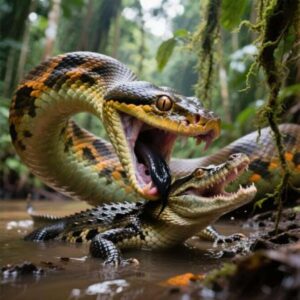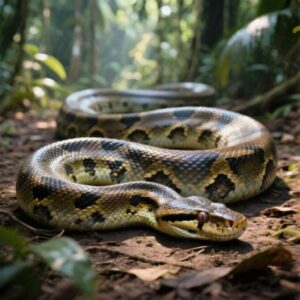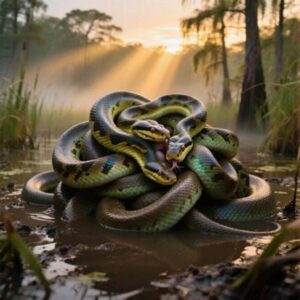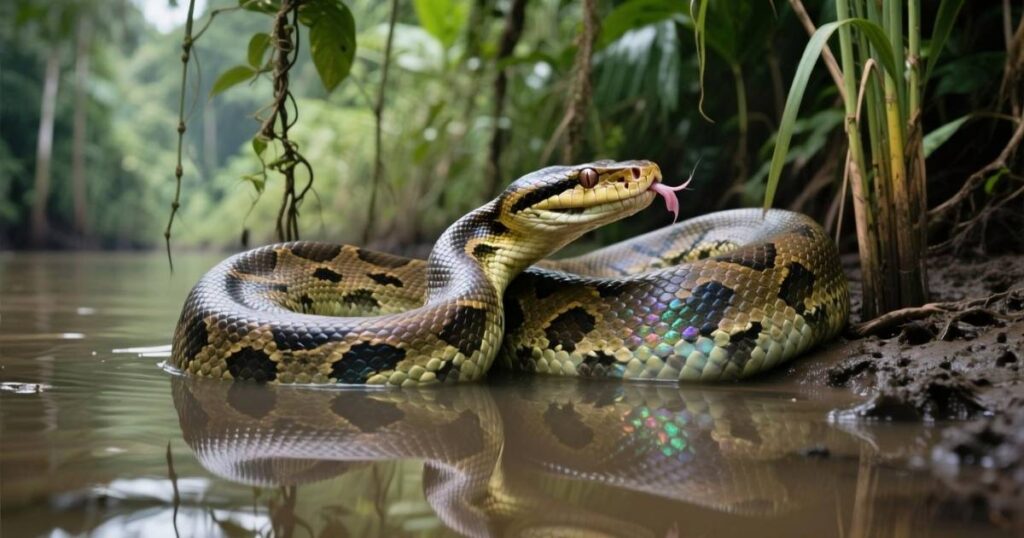Anaconda is one of the largest snakes in the world. This Anaconda snake lives mostly in the rivers and swamps of South America. People often confuse it with other giant snakes, but anacondas are unique. These water-loving snakes can grow very long and heavy.
Anacondas, also spelled anacoda, are famous in myths and movies. The word “anaconda” appears in many stories about giant snakes. Some call it anacondaannacondaanaconda snake jokingly, showing how well-known it is. These semi-aquatic snakes hunt fish, birds, and even mammals. Despite their size, they are rarely aggressive toward humans. Anacondas are strong swimmers. They hide well in water and wait for their prey. Learning about anacondas helps us understand their role in nature. They are not just scary creatures—they are fascinating animals that thrive in tropical South America.
Description
The Anaconda is a massive snake known for its thick, muscular body. Its skin is usually dark green with black blotches, helping it blend in rivers and swamps. Anacondas have a broad head, strong jaws, and sharp teeth. They are semi-aquatic, spending most of their time in water.
These snakes can grow over 20 feet long, with females much larger than males. Anacondas move slowly on land but are fast swimmers. Their eyes and nostrils sit high on the head, allowing them to see and breathe while mostly submerged. This anaconda snake is a patient hunter, often ambushing prey with incredible strength and stealth in tropical South America.
Origin and Fossil Record
Anacondas have a long history. Fossils show they lived from the Miocene period to recent times. Scientists study these remains to understand how these massive snakes evolved. The fossil record reveals their size and adaptations over millions of years.
Early ancestors of anacondas were smaller. Over time, they grew into the giant snakes we know today. Fossils like †Eunectes stirtoni from Colombia help trace their lineage. Museums display skeletons, giving people a closer look at these ancient water boas and their evolution.
The origin of the name “Eunectes” reflects their swimming skill. Ancient Greek εὐνήκτης means “good swimmer.” Fossil studies, combined with modern DNA analysis, show how anacondas survived changes in South America’s tropical rivers and wetlands.
Etymology
Etymology of the word “Anaconda” is fascinating. The name traces back to Ancient Greek εὐνήκτης, meaning “good swimmer.” Early naturalists used this term to describe the snake’s incredible swimming skills. The word reflects the anaconda’s habitat in rivers and swamps, highlighting its agility and power in water.
Some researchers link “anaconda” to Tamil origins. In Tamil, anai-kondra means “elephant killer,” showing how people imagined the snake’s strength. Others suggest a Sinhalese origin, Henakandaya, used in local folklore. Historical writings mixed these stories. The word gradually became popular in European texts over the 17th and 18th centuries.
Early explorers and scientists recorded the term in many works. Andreas Cleyer (1684) and John Ray noted it in animal catalogues. Peter Martyr d’Anghiera mentioned giant snakes in the Americas. Hobson-Jobson (1886) documented the word as it spread into English usage. It even appeared in Scots Magazine (1768).
The name “anaconda” also appears in various spellings. People wrote it as anacoda, anacondas, and even anacondaannacondaanaconda snake in playful texts. These variations show how the word evolved over centuries. They also reflect cultural fascination with the snake, which became a symbol of mystery and danger in tropical jungles.
Understanding etymology helps us see history and culture. The snake’s name connects language, folklore, and biology. By studying it, we learn how humans perceived this powerful reptile long before modern science. Today, the term “anaconda” reminds us of both its strength and its legendary status in South America.
Read More: Scientific Classification of Piranha Fish
Distribution and Habitat
Anacondas live in tropical South America, mainly in the Amazon Basin. They prefer slow-moving rivers, swamps, and marshes. These snakes are semiaquatic, spending much time in water to hunt and hide. Countries like Brazil, Venezuela, Colombia, and Ecuador are their main homes, with dense wetlands supporting their survival.
Distribution
Anacondas are native to tropical South America. They are mostly found in countries like Brazil, Venezuela, Colombia, Ecuador, and Argentina. Early explorers and naturalists documented them during river expeditions. Their wide range shows how well they adapt to wet environments.
The first formal descriptions of anacondas came from Linnaeus and Wagler. Scientists used specimens from the Amazon and Orinoco rivers. Over time, researchers confirmed their presence across swamps, marshes, and slow-moving rivers. This distribution highlights their semiaquatic lifestyle and ability to survive in diverse ecosystems.
Human activity affects their range too. Deforestation and habitat destruction shrink some populations. Still, anacondas remain common in protected areas. Local communities in South America have long observed and respected these giant anaconda snakes in rivers and wetlands.
Habitat
Anacondas live mainly in rivers, marshes, and swamps. They prefer slow-moving waters where they can hide and hunt. Dense vegetation and floating plants provide cover. Water helps them support their heavy bodies while moving silently to catch prey.
These snakes also thrive in flooded forests. Seasonal rains expand their habitat, letting them travel and hunt more effectively. They can survive in shallow waters, deep channels, and river edges. Semiaquatic life is ideal for their large size and swimming skills.
Habitat choice affects their feeding and breeding. Anacondas often stay near water with abundant fish and birds. They dig into mud or stay under roots for safety. This natural habitat ensures their survival while maintaining balance in South American river ecosystems.
Feeding

Anacondas are powerful predators. They mainly hunt in water and at the river’s edge. Fish, river birds, caimans, and even mammals like goats are part of their diet. They strike quickly and constrict their prey. In simple words, feeding for an anaconda means catching and slowly swallowing its meal whole.
These snakes have a slow but steady way of eating. After catching prey, they coil around it tightly. This squeezing is called constriction. It stops the prey from moving. Humans sometimes wonder why anacondas eat like this. It’s natural behavior. Feeding like this keeps the snake strong and helps it survive in rivers and swamps.
Anacondas don’t eat every day. They can go weeks without food after a big meal. This is because their digestion is slow, but efficient. They feed mostly at night and in water. Feeding is not just about hunger—it’s about energy for swimming, hunting, and even reproduction. This makes anacondas incredible hunters.
Relationship with Humans

Anacondas have fascinated humans for centuries. Indigenous people of the Amazon created myths about giant snakes, like the Yube and Anaconda Woman. These stories show respect and fear. Locals know how powerful anacondas are and often avoid their habitats. Today, these snakes are part of cultural traditions and folklore.
Despite their size, anacondas rarely attack humans. Most encounters happen near rivers or during floods. Scientists like Dr. Jesús A. Rivas study these snakes in the Venezuelan Llanos to understand behavior. Knowledge helps people stay safe while protecting the species. Awareness campaigns teach that anacondas are important for healthy ecosystems.
In modern times, anacondas appear in movies, comics, and documentaries. While films often exaggerate danger, they increase interest in conservation. Ecotourism also brings humans closer to rivers where anacondas live. Respect and education remain key to coexistence between people and these amazing snakes.
Size

Anacondas are some of the largest snakes on Earth. Green anacondas can grow over 20 feet long and weigh more than 550 pounds. Females are usually bigger than males. Their massive size helps them catch large prey and move easily through water. Despite their bulk, they swim with surprising speed.
Body length varies by species. Yellow anacondas are smaller, reaching 10–15 feet. Dark-spotted and Bolivian anacondas are medium-sized. Size depends on habitat, food availability, and age. Scientists measure anaconda skeletons in museums to track growth. These snakes can expand their body width to swallow large animals, making their size a key factor in survival and hunting.
Lifecycle
Anacondas begin life as eggs inside their mother, but they give birth to live young. A single female can have 20–40 babies at once. Hatchlings are tiny and vulnerable. They grow quickly, learning to hunt small fish and frogs. Survival depends on water, food, and hiding from predators.
Young anacondas mature in 2–3 years. Females grow larger than males, showing clear sexual dimorphism. Adults can live up to 10 years in the wild. Mating occurs in the dry season, often forming breeding balls. This lifecycle ensures strong, healthy snakes that maintain balance in rivers and wetlands. Understanding anaconda growth helps protect these giant snakes and their tropical habitats.
Species
Anacondas belong to the genus Eunectes and include 5 main species. The Green Anaconda (Eunectes murinus) is the largest. Others are Yellow, Dark-spotted, Bolivian, and Northern Green Anacondas. Each species lives in different parts of tropical South America.
Worldwide, anacondas are only found in South America. No other continent hosts them naturally. These snakes are semi-aquatic, thriving in rivers, swamps, and wetlands. Scientists continue studying their behavior, population, and distribution. Despite myths, they play a key role in local ecosystems as top predators.
Mating System
Anacondas breed during the dry season when water levels drop. Several males gather around one female, forming a “breeding ball.” Females are larger, giving them the advantage in choosing mates. Males use pheromones and pelvic spurs to compete. This unusual system shows strength, endurance, and survival instincts.
Sexual Dimorphism
Sexual dimorphism in anacondas is very noticeable. Females grow much larger than males. A female can reach more than 20 feet, while males are much smaller. This size difference helps females produce more eggs and survive longer. Males stay smaller but more agile, which helps in mating. The larger female body allows her to carry many offspring. Bigger size also provides strength during breeding balls. In these gatherings, several males surround one female. The female’s large body attracts mates and gives her dominance in reproduction. Size is directly linked to her success as a breeder. Males compete with each other for access to females. They rely on endurance, not fighting. Smaller males wrap around the female, trying to hold on longer than rivals. This strategy works well because stamina, not aggression, often decides who mates. Sexual dimorphism drives this unusual mating system. Research also shows females sometimes show sexual cannibalism. They may eat smaller males after or during breeding. This extreme form of dimorphism benefits the female by giving her extra energy for reproduction. Scientists believe this behavior is rare but proves how strongly size impacts survival and reproduction in anacondas.
Breeding Balls

Anacondas have a very unusual way of mating. During the dry season, several males wrap around one large female in what is called a breeding ball. This ball can last for weeks. Sometimes up to a dozen males compete, but only one gets to mate successfully.
In these breeding balls, males use persistence and strength to win. They push, twist, and even use tiny pelvic spurs near their tails. Females are usually much larger, giving them control. Scientists have also seen females mate with multiple males, increasing chances of healthy offspring.
After mating, the female carries her babies for about 6 to 7 months. Anacondas give birth to live young, not eggs. A single female may deliver 20 to 40 babies at once, though larger ones can give birth to more than 80 newborn snakes.
Sexual Cannibalism
Sexual cannibalism in anacondas is a rare but fascinating behavior. It usually happens when large females consume smaller males during or after mating. Since females are much bigger, they can overpower males easily. This behavior provides the female with extra energy, especially during pregnancy. Scientists believe sexual cannibalism boosts survival for mother and offspring. By eating a mate, the female gains valuable nutrients needed for reproduction. Research shows this behavior occurs in the wild, mainly during breeding balls. While shocking to humans, it’s a natural strategy in the snake’s mating system.
Asexual Reproduction
Some female anacondas can reproduce without a male. This rare process is called facultative parthenogenesis. In this case, the female produces embryos using her own DNA. The babies are genetic clones of the mother. Scientists confirmed this ability through DNA analysis of offspring born in captivity.
Asexual reproduction in anacondas usually happens when males are not available. In the wild, it is less common but still possible. This system allows the species to survive in isolated habitats. It also shows the flexibility of anaconda reproduction strategies compared to many other snakes.
Researchers found that young born through parthenogenesis often show lower survival rates. Still, this process proves how adaptable anacondas are in harsh environments. By using both sexual and asexual methods, these giant snakes increase their chances of survival. It highlights nature’s hidden strategies to keep species alive.
Indigenous Mythology
In many Amazon tribes, the anaconda is seen as sacred. The Huni Kuin people tell stories of Yube, a man who turned into a giant anaconda. This myth connects the snake to rivers and spiritual life. The anaconda often represents fertility, water, and transformation in their beliefs. Legends also speak of the Anaconda Woman, a mystical figure who controls the deep world of waters. Shamans say she teaches wisdom through visions. Rituals with ayahuasca, also called cipó, often include references to anacondas. People believe the snake guides them to hidden knowledge and healing powers. Indigenous people never view anacondas as only dangerous animals. Instead, they see them as protectors of the jungle and rivers. Myths describe them as creators of waterways and guardians of life. These stories show respect for the anaconda’s strength and its powerful connection to the natural world.
Conservation Status
The Anaconda snake isn’t officially endangered, but it does face threats. Habitat loss from deforestation and wetland destruction reduces their living space. Illegal hunting also happens, as people kill anacondas for skin or out of fear. Still, most species, like the Green Anaconda, remain widespread across South America.
Conservation groups monitor anacondas to protect them. Local laws in countries such as Brazil and Venezuela help prevent hunting. Researchers like Dr. Jesús A. Rivas study wild anacondas to learn about their behavior and population health. Protecting rivers, forests, and wetlands is key to keeping these powerful snakes safe for the future.
FAQ’S
What is the largest size they can reach?
The anaconda can grow over 20 feet long and weigh more than 200 kilograms. It is one of the heaviest snakes on Earth.
Where do they usually live?
These snakes live in tropical South America. Wetlands, rivers, and swamps are the natural homes where anacondas hunt, hide, and survive.
What do they eat in the wild?
The anaconda eats fish, birds, caimans, and even larger animals like deer. Its powerful grip helps it overpower prey quickly in the water.
Are they dangerous to humans?
They rarely attack humans. Most encounters show anacondas avoiding people, as they prefer staying hidden in rivers and marshes rather than seeking human contact.
How do they reproduce?
Mating happens in water during the dry season. Females attract several males, forming breeding balls, and later give birth to live young snakes.
Conclusion
The anaconda is one of the most powerful snakes in the world. It lives in rivers, swamps, and wetlands of South America. People often think of it only as a dangerous animal, but it plays a big role in nature. By controlling the population of fish, birds, and other animals, this giant snake keeps the ecosystem balanced. Many myths and stories have made the anaconda famous, but the real animal is even more interesting than the legends.
Anacondas are strong swimmers and skilled hunters. They are shy and usually avoid humans, which shows they are not as threatening as movies suggest. Their ability to survive in the wild for years is remarkable. Scientists continue to study their growth, feeding habits, and breeding system. Protecting these snakes is important because they are a vital part of South America’s wetlands. The anaconda deserves respect for its size, power, and mystery.


1 thought on “Anaconda”